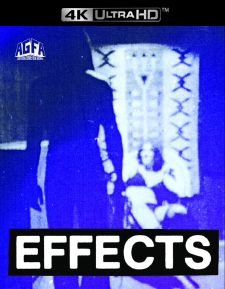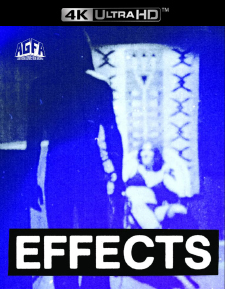Effects (4K UHD Review)

Director
Dusty NelsonRelease Date(s)
1979 (July 25, 2023)Studio(s)
Image Works (American Genre Film Archive/Vinegar Syndrome)- Film/Program Grade: C+
- Video Grade: B+
- Audio Grade: B
- Extras Grade: A-
Review
Effects is a low-budget independent horror movie that’s had a long and genuinely strange journey over the decades. It was originally shot in 1978 and had a local Pittsburgh premiere in 1979, but then its planned theatrical release was scuttled due to a bad distribution deal. It was resurrected in 2005 thanks to a DVD release from Synapse, and made a few festival appearances during the years that followed, finally landing on Blu-ray via the American Genre Film Archive. That disc went out of print, but thanks to the discovery of the original camera negative a few years later, it now exists in a form that its creators never could have envisioned back in 1979: 4K Ultra High Definition. That’s pretty impressive for a film that was shot in 16 mm and intended to be blown up to 35 mm, with all of the image degradation that process inevitably entails.
Effects was the brainchild of a group of friends and associates of Pittsburgh filmmaking legend George A. Romero: writer/director Dusty Nelson, producer/editor Pasquale Buba, producer/composer John Harrison, and effects master Tom Savini. They raised about $55,000 from friends and family to bring it to life, shooting everything on 16 mm short ends that they had scraped together from the industrial and commercial films that they were making at the time. Nelson’s story was supposedly based on the novel Snuff by William H. Mooney, but good luck tracking the book down. There doesn’t appear to be any evidence that Mooney ever published anything by that name, even though Nelson still maintains that he did. (Where the subject of snuff films is concerned, fact and fiction sometimes intermingle freely.)
The reality is that urban legends about snuff films were quite topical at the time, thanks in no small part to Allan Shackleton’s infamous 1976 production Snuff, which purported to be an actual snuff film. In reality, it was nothing more than Michael and Roberta Findlay’s 1971 quickie Slaughter, re-edited and with a new non sequitur of an ending added by director Simon Nutchern. Whatever Shackleton may have lacked as a producer, he more than made up for it with William Castle levels of inventiveness as a promoter, and so Snuff gained quite a bit of notoriety. Maverick Italian director Ruggero Deodato ended up capitalizing on that with his found footage classic Cannibal Holocaust in 1980 by having his actors agree not to make any public appearances for a year following the release of the film—a stunt that helped to land him in court. So, it’s not too surprising that Nelson and company also turned to a similar kind of material for their debut feature.
While Deodato’s story would end up following hapless documentary filmmakers meeting their fate in the jungle, Nelson’s spin was to make an independent horror film about a group of filmmakers making an independent horror film, blurring the lines between the two. Led by director Lacey Bickel (Harrison), the cast and crew (Joseph Pilato, Susan Chapek, Bernard McKenna, Debra Gordon, and Savini) slowly begin to discover that there may be more going on behind the scenes of their production than meets the eye. One night, Bickel shocks everyone by showing a supposedly real snuff film to them, only to reveal that it was actually a fake that he created himself. Or was it? The answer to that question becomes critical as some of them begin to suspect that their own lives may be in danger. Effects also stars Charles Hoyes and Blay Bahnsen.
Savini is always a welcome presence on both sides of the camera, and it’s nice to see the late Pilato (Day of the Dead) in a leading role. Yet the most pleasant surprise in Effects is Harrison, who makes a strong impression as the oily but sinister Bickel. Harrison’s first instinct was to play the role in an overtly menacing fashion, but at Nelson’s suggestion, he dialed that back in favor of a much more effectively low-key approach. That created a sense of ambiguity, which helps to keep audiences guessing as to whether or not Bickel is really responsible for what’s going on behind the scenes, or nothing more than a red herring. Effects isn’t exactly a subtle film, but uncertainty like that it what keeps it interesting. Where Deodato openly went for the jugular, Nelson opted to slowly get under the audience’s skin instead. It’s a shame that so few people saw it back in 1979, but it still became something of an urban legend of its own, and fortunately it’s now widely available—and in 4K, to boot.
Cinematographers Carl Augenstein and Toni Semple shot Effects on 16 mm film using either Arriflex 16SR and Eclair ACL16 cameras with spherical lenses. While they doubtless exposed full-frame, they composed at 1.85:1 for blowing up to 35 mm prints. This version uses a 4K scan from the original camera negative, framed at 1.85:1, that has been graded for High Dynamic Range (only HDR10 is included on the disc). The damage to the original negative hasn’t been completely cleaned up, so there are a few scratches, speckles, and other minor bits of damage on display. The 16 mm grain is quite heavy, but the encoding handles it perfectly—the disc runs at an impressively high bitrate, peaking over 105Mbps. The fine detail is as well-resolved as it can be, but there simply isn’t anywhere near 4K of resolution available on 16 mm film regardless of format. The HDR grade enhances the colors slightly, with the greens and the reds appearing just a touch more vivid, although it’s worth noting that the actual gore effects in Effects still didn’t use the Dick Smith formula for fake blood. That means that the blood has the same unnatural coloration as the stage blood that Savini used in Dawn of the Dead. Black levels are adequate, and the highlights peak slightly higher than they do in the SDR version—it’s visible in light sources such as the light over the bar door at 13:10, and the halation around all of the light sources seems a bit more intense in HDR.
Audio is offered in English 2.0 mono DTS-HD Master Audio, with optional English subtitles. It sounds surprisingly good given the ultra-low budget nature of the film, with the only apparent defects being deliberate ones—the quality of the sound shifts slightly as it flips back and forth between the film and the film within the film. There’s a bit more hiss and distortion during the latter sequences, but that was a way of differentiating them from the “real” footage in the surrounding material. Harrison naturally provided the score, and his work generally sounds clear.
The American Genre Film Archive 4K Ultra HD release of Effects is a two-disc set that includes a Blu-ray with a 1080p copy of the film, as well as a 12-page booklet featuring an essay by Joseph A. Ziemba and an interview with Dusty Nelson. There was a Limited Edition slipcover available directly from Vinegar Syndrome, but it’s already sold out. Aside from the commentary track, all of the extras are included on the Blu-ray only:
DISC ONE: UHD
- Audio Commentary with John Harrison, Dusty Nelson, and Pasquale Buba
DISC TWO: BD
- Audio Commentary with John Harrison, Dusty Nelson, and Pasquale Buba
- 35 mm “Grindhouse” Preservation (HD – 83:30)
- Restoring Effects (Upscaled SD – 22:33)
- After Effects Documentary (HD – 59:37)
- Photo Gallery (HD – 2:35)
- Short: Ubu (HD – 12:10)
- Short: Beastie (HD – 15:38)
The sole new extra is Restoring Effects, which is a Zoom Q&A that focuses on the distribution, restoration and preservation of Effects. It features Nelson and Harrison, as well as AGFA staff members Joe Ziemba, Bret Berg, Ivan Peycheff, and Sebastian Del Castillo. They discuss working with DuArt to do the original blowups, dealing with the 35 mm print for previous home video versions, and discovering the original 16 mm negative at FotoKem. Harrison asks the valid question why AGFA would want to produce a 4K UHD of Effects, so Ziemba and the others explain why it makes sense for them at this stage of the company’s development.
The commentary with Harrison, Nelson, and Buba was originally recorded for the 2005 Synapse DVD release of Effects. They reminisce about the whole experience of making the film, from financing it the eventual disappointment in its distribution. They also discuss some of its thematic implications. The three of them have obviously shared some long, hard miles together, and they complement each other nicely on this track.
After Effects is a documentary about the making of Effects that was edited and directed by Michael Felsher of Red Shirt Pictures. It was also originally included on the 2005 Synapse DVD. Subtitled Memories of Pittsburgh Filmmaking, it centers around a 2004 reunion between Dusty Nelson, John Harrison, Pasquale Buba, Joe Pilato, and the godfather of Pittsburgh filmmaking, George A. Romero. It also includes separate interviews with Tom Savini and stunt person Marty Schiff, as well as actors David Belko, Bernard McKenna, Susan Chapek, and Debra Gordon. It opens with an overview of their history together with industrial films at The Latent Image and television documentaries like The Winners, before moving on to the production of Effects. They offer some fascinating (and frequently amusing) behind-the-scenes stories about making the film, as well as some thoughts about its legacy. After Effects can also be played with an optional commentary by Michael Felsher, who talks about his own career and explains the importance of this documentary to him, since it was the first long-form piece that he ever created.
Ubu and Beastie are two short films, the former directed by Harrison, and the latter by Nelson. Ubu is an oddity that’s better seen than described—although if you’ve already watched After Effects, you’ve seen some clips from it. Beastie is a more conventional story about a hitchhiker who strikes up a relationship with a man who picks her up one day.
Finally, the 35 mm “Grindhouse” Preservation has been transferred from the only known extant 35 mm blowup of Effects. It’s heavily damaged throughout, and none of that damage has been cleaned up for this version, so it certainly qualifies for the grindhouse label. Flaws or not, it’s a more accurate presentation of what Effects might have looked like during its theatrical release, since it was never intended to be seen with the kind of quality that a 4K scan from the 16 mm negative can provide. It’s also a preservation of what Effects looked like on home video prior to the rediscovery of the original negative. It’s a great reminder that we truly do live in fascinating times for physical media collectors.
Effects may seem like a strange choice for a 4K Ultra HD release, but hat’s off to AGFA for not just giving fans what they may have wanted, but also giving them more than they could have possibly asked for. It’s doubtful that anyone had “The definitive home video release of EFFECTS” on their 2023 physical media bingo card, but here it is, larger than life and twice as natural. It’s an essential disc for fans of the film.
- Stephen Bjork
(You can follow Stephen on social media at these links: Twitter and Facebook.)

